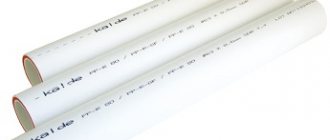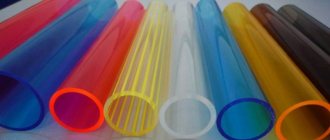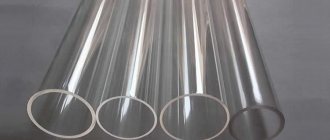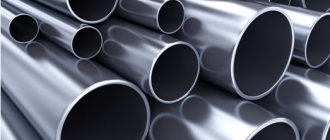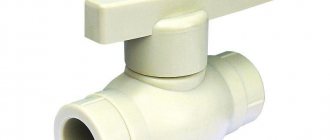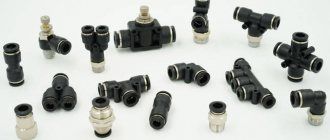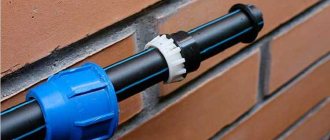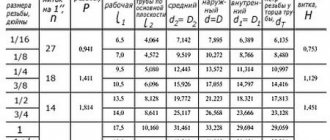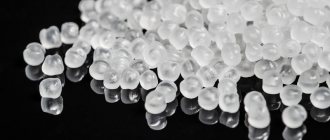In modern in-house engineering systems of water supply, heating, and sewerage, metal pipes can be seen less and less often. They have almost been replaced by polymer analogues: pipes made of polyethylene, polypropylene, polyvinyl chloride, polybutene.
The first two types are most often used - polyethylene (PE) and polypropylene (PP). Pipes made from them have significant advantages over metal ones: they are lighter in weight, which facilitates installation and transportation, are not subject to corrosion, and can withstand high temperatures.
When choosing pipes, the chemical, physical and operational properties of both types are taken into account.
General properties of plastic pipes
Often in everyday life it is customary to simplify the division of pipes into metal and non-metal. All pipes not made of steel or copper are called plastic. Indeed, in appearance, polyethylene and polypropylene products are similar and resemble plastic ones, the properties of both pipes are identical, both types:
- low melting point compared to metal ones (when heated strongly, they soften and sag);
- light weight, making them easier to transport and install.
- resistance to mechanical damage - shock, vibration;
- they are not afraid of alkaline reagents in tap water;
- do not conduct electric current;
- susceptible to destruction under the influence of ultraviolet radiation;
- cannot be bent, because break under strong tensile pressure.
A significant advantage of non-metallic products for engineering systems is resistance to organic and inorganic sediment.
The metal interacts with oxygen and salts of alkaline earth metals (hardness salts) found in water and leads to the formation of sediment, which gradually thickens, which does not threaten polyethylene and polypropylene pipes, which do not become clogged even after decades of operation, because have a smooth inner surface.
Advantages
- The biggest advantage of this material is its low cost. In the Moscow region, the average price for polypropylene pipes is 60 rubles per meter, and corners cost about 20. However, despite this, end switches intended for threaded connection of pipes with metal elements are sold more expensively - 150 rubles per piece, so if in the system has many metal-plastic transitions, repairs can hit your pocket hard.
- Also a plus is the relatively simple installation. To connect a polypropylene pipe with a corner, you just need to insert them into each other and solder them - a procedure that is accessible even to a child.
Differences between polyethylene and polypropylene pipes
Despite their external similarity, PP and PE pipes have a number of significant differences:
- different chemical formula - (CH2)n for polyethylene and (C3H6)n for polypropylene;
- different melting temperatures - polypropylene is more resistant to heat and melts at 160-180°C, while polyethylene can withstand an average of 103°C (depending on the type of PE);
- permissible pressure – for PP – up to 20 atmospheres, for PE – 16 atmospheres.
We recommend that you read: Features of cross-linked polyethylene for pipe production and their scope of application
In other physical and mechanical parameters, such as strength, flexibility, density, frost resistance, these materials also differ. Polypropylene is superior to polyethylene in strength and heat resistance (begins to deteriorate at 75°C), but is inferior to polyethylene in frost resistance and flexibility.
Important! It is necessary to distinguish between ordinary polyethylene (labeled as PE) and the so-called. cross-linked (PE-X), which, thanks to a special technology for connecting molecules, obtains almost the same strength, heat resistance and ultraviolet resistance as polypropylene. However, cross-linked polyethylene pipes are almost impossible to weld with a soldering iron.
Polypropylene and polyethylene (“cross-linked”) pipes can be used for installation in cold and hot water supply, heating and sewerage systems, as well as “warm floor” systems and other engineering systems.
Operational differences
In operation, PP and PE pipes also have similarities and differences. The service life of both types of plastic pipes in a cold water supply system is 50 years, in a hot water supply system - 25 years. They also withstand low temperatures well and even allow water in the system to freeze.
But PP pipes have one drawback - they have a high coefficient of thermal expansion and often begin to sag when installed in hot water supply and heating systems. Pipes made of simple polyethylene also expand quite strongly when heated with hot water, but cross-linked polyethylene does not have this drawback.
Another important difference between PP and PE in operation is the presence of potentially dangerous toxic substances. Polypropylene is considered absolutely harmless; it does not emit toxic components when heated, melted and burned. Polyethylene produces a small emission of toxic decomposition products when exposed to high temperatures.
Important! The most significant difference between PP and PE pipes is installation. To install PP pipes, you need to use special welding machines for heating and coupling. PE pipes will have to be installed using special adhesives or additional fittings and flanges must be used, but they cannot be melted with a soldering iron.
Price
The price range of polyethylene and polypropylene is not significantly different. The difference in price in favor of one material or another may depend not only on their physical properties, but even on the policy of the manufacturer, brand, origin (imported or domestic).
We recommend that you read: Choosing a machine for high-quality welding of polyethylene pipes
Pipes made of cross-linked polyethylene are usually 15-20% more expensive, because... More complex molecular technology is used to produce them. The price is also affected by the diameter and thickness of the pipes, the density of the material, and markings (for hot/cold water). Here it is impossible to give an unambiguous definition of what is cheaper/more expensive, because... both materials are included in the category of plastic (polymer) pipes.
Flaws
- The main disadvantage is that the pipe has virtually no flexibility. This is especially disadvantageous if, for example, you need to assemble a complex curved line - you will need a large number of corners, which means you will have to do a lot of welding.
- Polypropylene pipes are quite bulky. To provide them with strength and a certain rigidity, it is necessary to make a large diameter, 20-25 mm. But such a pipe, of course, cannot withstand high pressure.
- "Human factor". If the installer does not pay attention during soldering, or a low-quality soldering machine is used, in general, if the person assembling the pipes somehow makes a mistake, the system may leak.
Application of polyethylene and polypropylene pipes
In practice, there is not much difference in where it is better to use polyethylene and where polypropylene pipes (if we are talking about cross-linked polyethylene). Both materials perform well in various conditions, being almost equally durable and resistant to high/low temperatures.
However, it is recommended to use both types of pipes for installation in enclosed spaces, because polymers quickly degrade when exposed to ultraviolet radiation.
If you are faced with a choice of which pipes to use for in-house engineering systems, take into account individual parameters in installation and operation. For example, cross-linked polyethylene pipes are quite easy to install using simple sealing fittings.
For polypropylene, you will need a special welding apparatus (“iron”), which must have the same diameter of melting nozzles as the pipes you have chosen.
Negative features and reviews about them
According to consumers, the described material also has its drawbacks. For example, cross-linked polypropylene exhibits low resistance to solar radiation. If ultraviolet radiation is exposed to pipes for a long time, the material will begin to deteriorate and become brittle.
Buyers also emphasize that polypropylene is destructively affected by oxygen if it penetrates into the molecular structure. However, these problems can be eliminated by protecting products or adding special substances at the product creation stage.
Internal differences
Let's try to understand the differences in the properties of cross-linked polyethylene and polypropylene by turning to the features of their structure:
- PEX polyethylene is produced by cross-linking linear macromolecules of polymerized ethylene to obtain a three-dimensional mesh-cellular structure:
- The strong intermolecular bonds formed in this process give the material high resistance to mechanical, chemical and thermal loads.
- Such connections, even at the casting stage of the product, give it a shape that will then be very difficult to change.
- PEX is the densest of all types of polyethylene with an index of 940 kg/m 3.
- Polypropylene is a polymer of propylene hydrocarbon that has an unstable crystalline structure, which gives it both high tensile and tensile strength and high ductility. He:
- There can be three types depending on the spatial direction of the branches of the molecules (methyl groups),
- It has a “breathing” structure that can allow gaseous substances to pass through,
- It is a much less dense material than any other type of plastic, with a density index from 850 to 900 kg/m3.
Rating of meat grinders
- Material – food grade plastic, metal, combined body;
- Power – rated from 130 to 850, maximum up to 3000 W;
- Knives – quality steel, anti-corrosion coating, self-sharpening;
- Motor protection - automatic shutdown;
- Productivity - the amount of meat per unit of time;
- Attachments – vegetable cutter, juicer, etc.;
- Reverse – to remove stuck particles without disassembling;
- Noise level – the quieter the better;
- Stability – tendency to vibration, noise;
- Dimensions – compact or bulky models.
When choosing, much depends on the purpose of such a unit. For many buyers, an important criterion is the price tag. Therefore, when creating the top list, the ratio of price and quality was taken into account. Feedback from experts, real user feedback, their experience and advice helped identify the strengths and weaknesses of each nominee.
The best pans for an induction cooker
The differences are chemical
Both materials have the word "poly" in their names, which means "many" in Greek. In our country, most scientific terms are borrowed from Greek or Latin - this has been the custom for a long time. That is, “polyethylene” means “a lot of ethylene,” and “polypropylene” means “a lot of propylene.” What are ethylene and propylene?
Under normal conditions, both of these chemical compounds are flammable gases. The formula of ethylene is C2H4, the formula of propylene is C3H6. They occupy the first and second lines of the class of compounds, which is called “alkenes”, or “acyclic unsaturated hydrocarbons”. Their general formula is CnH2n, that is, there are always twice as many hydrogen atoms (H) in the molecule of any alkene as there are carbon atoms (C). This means that the third in the row will have the formula C4H8, the fourth - C5H10, etc.
Polyethylene granules
We've dealt with ethylene and propylene, let's move on. What is the difference between polyethylene and polypropylene, and how is a popular packaging material made from flammable gases? A special process is used to produce polyethylene and polypropylene. It is called "polymerization". Its essence is that long chains are obtained from gas molecules, consisting of a huge number of “bricks”, each of which is a C2H4 unit (for polyethylene) or C3H6 (for polypropylene). Material made from such polymer chains has properties that are fundamentally different from the properties of the original molecules, although the chemical formula remains almost the same: (C2H4)n and (C3H6)n, where n is the number of units in a polyethylene or polypropylene molecule.
Results: each polymer is a good solution for its tasks
Each of the materials has its own scope and its own advantages that need to be used:
- High-density polyethylene is optimal for inexpensive and relatively reliable packaging.
- Low-density polyethylene is well suited for the manufacture of durable but elastic products (pipes, dense films).
- Polypropylene is better suited for food containers, containers and can be used as a building material.
By separating the areas of application, you can get the maximum benefit from the existing differences between these polymers.
Production of cross-linked polyethylene
The initial raw material for the production of cross-linked polyethylene is the simplest gaseous hydrocarbon, ethylene. It consists of 2 carbon molecules and 4 hydrogen molecules. Polyethylene is produced through polymerization (a reaction during which ethylene molecules are linked together into long hydrocarbon chains with identical “CH2” units). The material is a transparent thermoplastic substance that is widely used to produce, for example, household plastic bags.
In industrial production, polyethylene is produced in granular form. This material melts easily and becomes soft already at 40 degrees. Without further processing, it is impossible to obtain strong heating pipes from polyethylene.
To produce a particularly durable material (cross-linked polyethylene), plain polyethylene is subjected to further chemical and physical attack.
Cross-linked polyethylene is a material in which long chains of molecules are equally oriented and connected to each other by additional lateral bonds. These bonds occur instead of a pair of hydrogen atoms taken from the polymeric hydrocarbon molecule ethylene. The more such lateral bonds, the more resistant the cross-linked polyethylene is to external influences.
Note! The number of stitching bonds formed directly depends on the stitching method.
There are many ways to remove hydrogen atoms from the ethylene polymer molecule. The reaction was first carried out by a Swedish chemist back in the last century, but he considered that the resulting substance had no practical use. The technology was bought from the author by a Swedish company, which labeled its product as PEX. Consumers still know cross-linked polyethylene under this label today.
We recommend that you read: Sound insulation methods to reduce noise in a sewer riser
There are about 15 ways to stitch polyethylene. Today, 3 methods of producing cross-linked organic polymers are used on an industrial scale:
- PEX-A. Treatment of polyethylene with peroxide. The reaction is carried out at elevated pressure and constant temperature control. Peroxide, being an oxidizing agent, during decomposition takes away hydrogen atoms from polymers, forcing carbon atoms to form bonds with each other. As a result, a three-dimensional network of very long chain molecules is formed, in which up to 85% of carbon atoms have lateral bonds with a neighboring molecule. Crosslinking polyethylene with peroxide is the most effective method. However, the features of the technological process increase the cost of the output material.
- PEX-B. Pipes of this brand are produced in two stages. At first, silane is introduced into polyethylene. At the second stage, the product is saturated with water in the presence of a catalyst. The result is cross-linked polyethylene, with a percentage yield of additional bonds of 65%.
- PEX-C. Cross-linking of polyethylene by radiation. Here it is important to monitor the spatial orientation of the product relative to the radiation source. The share of bond formation is about 60%.
Until recently, nitrogen cross-linking (PEX-D) was used to produce cross-linked polyethylene pipes. Now the share of such pipes on the market has disappeared.
Note! Pipes made of cross-linked polyethylene differ not only in price, but also in performance characteristics, depending on the technology used to produce them.
Advantages
- PEX pipes have a significant advantage over polypropylene pipes - they can bend and keep their shape. This greatly simplifies their installation, especially in geometrically complex systems. But there is also a type of non-plastic PEX that, with any bending, immediately returns to its original form. Such pipes are cheaper, but if you need to make an angle, they have to be fixed with special fasteners. The first ones are marked as FLEX (read as flex), and the second ones Stabil (stable).
- They can withstand quite high temperatures - up to 95 degrees.
- A lower diameter than that of polypropylene pipes - the water flow rate and pressure that the PLP pipe can withstand with a diameter of 25 mm, PEX duplicates with a diameter of only 16.
- Simple installation, without the so-called “human factor”. To connect two sections of the pipeline, you just need to crimp the ring with pliers and twist it until it stops. That is, it is basically impossible to make a mistake here that could lead to a leak.

